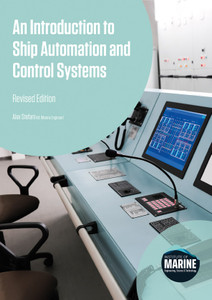
This book provides practical information on the characteristics, construction, operation and maintenance of controllable pitch propellers (CPPs). It is written in a clear and interesting style that does not require specialist knowledge and features numerous explanatory diagrams and illustrations.
Topics include a brief history, characteristics of CPPs and their resultant applications, forces and moments on propeller blades, constructional and working principles, hydraulic and control systems, installation, operation, ship handling, troubleshooting and maintenance. In addition, there is discussion on cavitation, erosion, noise and vibration.
The book will be a useful source of reference for personnel responsible for selecting and designing machinery systems, building and commissioning ships with CPPs, ship managers, marine engineering students, as well as ships? crews who operate and maintain CPPs.
In a controllable pitch (CP) propeller the blades can be turned simultaneously about their own axes, which are normally perpendicular to the propeller shaft, so that the angles (or pitch) of the blade can be altered. The available range of movement normally includes astern pitch angles so that a reverse thrust can be generates without the need to change the propeller?s direction of rotation.
The first CP propellers were only capable of changing pitch when they were not rotating and under minimal hydrodynamic load. Reliability was poor and such propellers are now only used on small yachts.
CP propellers that were capable of changing pitch while rotating were developed early in the 20th century after diesel engines were introduced and CP propellers became desirable as a means of reversing ships and improving manoeuvrability. These early CP propeller designs had simple mechanical pitch setting mechanisms which were hand-operated and used mainly for trawlers and other small vessels.
Later, the first hydraulically operated CP propellers were introduced and fitted to ocean-going passenger ships.
The CP propeller hub diameters, about 30% of the total propeller diameter, were larger than the hub diameters of fixed patch (FP) propellers which were typically about 20% of propeller diameter, but this was of little significance. CP propellers proved to be sufficiently reliable to be accepted by the Classification Societies and owners, and were subsequently fitted to many coasters with diesel engines to improve manoeuvrability.
After World War II interest in CP propellers increased and many types of ship are now commonly equipped with them. In particular, the use of gas turbines as prime movers for fast warships led to the widespread adoption of high powered CP propellers, which provide for effective reversing and improved manoeuvrability.
CP propellers are now fitter in about 25% of all merchant ships newbuildings, and the trend is increasing although, for some applications, there is growing competition from variable speed electric propulsion motors driving FP propellers.
The latest propeller produced to date has a diameter of 11 metres. It is a three blade propeller and absorbs 15,500 bhp (11,400 kW) at the very low rotational speed of 45 rev/min.
CP propellers are in service at 50,000 bhp (equivalent to 37,000 kW) for warships and 46,000 bhp (34,000 kW) for a merchant ship.
Acknowledgments
Greek Alphabet
List of Figures
List of Abbreviations
Chapter 1 Introduction
Chapter 2 Characteristics of CP Propellers
2.1 Bollard Pull
2.2 Manoeuvring
2.3 Windmilling
2.4 Operation with Different Machinery Modes
2.5 Astern Running
2.6 Zero Thrust Operation
2.7 Full Power Operation
2.8 Crash Stop
Chapter 3 CP Propeller Applications
Chapter 4 Economic Considerations
Chapter 5 CP Propeller Blades and Geometry
5.1 Definitions
5.2 Blade Sections
5.3 Design Pitch
5.4 Pitch Change Effects
5.5 Skew
5.6 Rake
5.7 Blade Outlines and Areas
Chapter 6 Forces and Moments on Blades 39
6.1 Thrust and Torque 41
6.2 Centrifugal Loading 42
6.3 Spindle Torque 43
6.4 Skewed Blades
Chapter 7 Working Principles
7.1 Small CP Propellers ? Inboard Actuation
7.2 Larger CP Propellers ? Servomotor in Hub
7.3 Hubs with Double-Acting Servomotor
7.4 Feathering Propellers
7.5 Adjustable Pitch Propellers
7.6 Materials
Chapter 8 Hydraulic Systems
Chapter 9 Control Systems
Chapter 10 Installation
10.1 Installation Design
10.2 Setting-up at Builder?s Trials
Chapter 11 Operation of CP Propellers
11.1 Before Main Engines are Started
11.2 Before Going to Sea
11.3 Operation at Sea
11.4 Manoeuvring in Confined Waters
11.5 Manual Control
11.6 Emergency Pitch Locking
11.7 Ship Handling Characteristics
Chapter 12 Troubleshooting
Chapter 13 Maintenance
13.1 Maintenance at Sea
13.2 Maintenance in Harbour
13.3 In Dry Dock
13.4 Blade Maintenance
Chapter 14 Cavitation, Vibration and Noise
14.1 Cavitation
14.2 Vibration
14.3 Noise
14.4 High Skew Blades
Chapter 15 Future Trends
Keith Brownlie served as Design Engineer with AEI Turbine Generators Ltd (later GEO) for 13 years, before joining Stone Manganese Marine as Chief Designer, Engineering. He then became Manager, Mechanical Applications at GEC Gas Turbines Ltd, before moving to Stone Vickers Ltd (now Rolls Royce) to become Technical Director from 1982 until his retirement in 1995.
- Number of Pages:
- 128
- ISBN:
- 1914993532
- Published Date:
- August 2023
- Book Height:
- 250 mm
- Book Width:
- 0.6 mm
- Weight:
- 0.4 kg
- Publication Date:
- August 2023
- Author:
Keith Brownlie
- Preview:
- Yes






